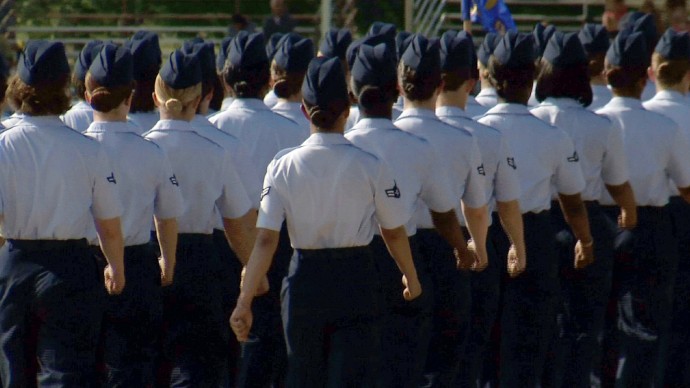
There are two recent events that are fresh in our memories that highlight the painful reality of sexual assault within our military and why it has been difficult to address. The first is the recent scandal at Lackland Air Force Base, in San Antonio, Texas, where investigators say at least 38 female trainees were victimized and 15 instructors have been implicated.
The second incident involves Missouri U.S. Congressman Todd Akin’s remarks regarding what he called “legitimate” rape and what actually happens with the female reproductive system during an actual sexual assault. It is in light of these realities and declarations, that are representative of a much more widespread mindset, that the rape and sexual assault of our U.S. female service members has to be viewed.
An estimated 19,000 rapes and sexual assaults took place in the military last year. The fact that so few victims — just 1 in 7 — report these crimes emphasizes the near non-existent trust that female service members have in the military justice system or culture.
The rate of sexual assaults within the U.S. military exceeds that of the general population. A Pentagon report from 2009 found 1 in 3 female service members are sexually assaulted at least once during their enlistment (63 percent of the nearly 3,000 cases reported during that year were rapes or aggravated assaults). Despite what some have called an epidemic of military sexual trauma, the delivery of healthcare to women veterans remains grossly inadequate.
Their stories … their pain
A documentary by French journalist and filmmaker Pascale Bourgaux titled, “Rape in the Ranks: The Enemy Within” addresses this epidemic by featuring and highlighting the lives of three women who were sexually assaulted while serving in the U.S. armed forces.
One of the victims, Tina Priest, was found dead in Iraq in March 2006 just weeks after she had accused a male soldier of raping her. Her family was told she took her own life, but they don’t believe that. They think she may have been killed because she came forward with the rape accusation.
When asked about her daughter’s death, Joy goes on to say, “She died in Iraq from what the Army says was a self-inflicted gunshot wound to her chest. That’s what the Army says. I don’t-I don’t know how she died. I want to find out how she died.
“There are so many different opinions. I don’t-I don’t see her killing herself. But if she did, I can understand why [she did].
“Yes, because of the trauma that she had been through with the rape and the way that people treated her afterwards. And so, I can see how she would be depressed enough to do that. But it’s not like her.”
At her own expense, Joy Priest consulted a ballistics specialist. The independent expert had serious questions concerning the official theory of suicide.
Now, it can’t be said, definitively, what actually happened to Tina Priest in regard to her death, her sexual assault, however, fits the narratives of many former and current female service members and the Pentagon’s own report.
The Pentagon’s annual report on sexual assault showed a sharp 8 percent increase overall in reports of sexual assault over 2008’s survey, but data compiled for the report show an even sharper 26 percent increase specifically in Iraq and Afghanistan. Defense officials attributed the increase in part to greater awareness to report sexual assault and rules that make it easier to report sexual assaults.
In fiscal year 2008, the Pentagon says the military services received a total of 2,923 reports of sexual assault involving service members as victims or assailants compared to the 2,688 reports filed in fiscal year 2007. Fiscal year 2008 is defined as beginning on Oct. 1, 2007 and ending on Sept. 30, 2008.
The problem of reporting
Dr. Kaye Whitley, Director of Defense Department’s Sexual Assault Prevention and Response Office, believes that the increase in reports means the department’s policy of encouraging victims to come forward is making a difference. A great deal of that confidence comes from the U.S. military’s implementation of a, fairly recent, category of filing assaults.
Filing the assaults under a category known as restricted reporting removes barriers in reporting sexual assault crimes for military victims. Under this option, victims get access to psychological and medical care, but choose not to pursue a criminal investigation while maintaining their anonymity. The victims then have a year to pursue charges if they change their mind.
Restricted reporting was first offered as an option about six years ago because Pentagon officials said some victims were foregoing services rather than participate in the investigative process and risk their commanders being notified.
This program seems to be, however, a bit like blackmail. It says, essentially, that we will take you at your word that you have been raped or sexually assaulted; we will give you the cadre of services that you need, but we will allow your attacker to escape full or complete justice. In the face of these crimes against female servicemembers, our response should not be so tepid.
Additionally, of the sexual assaults reported and recorded by the Department of Defense in fiscal year 2007, half were met with no official action, a third were dismissed as unworthy of investigation and only 8 percent of those investigated were referred to Court Martial. Of those few military men found guilty of rape or sexual assault, the majority received punishments so mild they amounted to slaps on the wrist, conveying the message that men can do what they want to women in the military with little consequence.
In 2007, the Department of Veterans Affairs reported that 20 percent of female veterans seen at its facilities nationwide said they had been raped or sexually assaulted while serving. Further, the Department of Defense admits on its website that 80 percent of rapes in the military are not reported because women (and the men who are raped, too) fear ostracism, punishment and loss of careers. The rate of sexual assault and rape in the military is at least twice as high as it is among civilians.
Tinker, tailor, soldier, sister, wife
The aforementioned ostracism is also touched on in the Bourgaux documentary. A military veteran, Stephanie, said she was too afraid to take action after she was sexually assaulted. She also lost her husband, who took his own life after serving in the military.
Stephanie in her own words: “I was sexually assaulted. And when I went days later to see someone about it, because I was bleeding very heavily, she was a higher-ranking officer, and she told me, of course, that it was very stupid that I put myself in that situation. In so many words, she said that. And she asked me how could I not know that that could happen to me and kind of placed the blame on me.
“But I was also an officer, and I should have been the one to step up to the plate at that time. So I was guilty, too, of telling people, ‘well, you should move on and go on with your career.’ So I was guilty, too, of that. And I think it’s a very common attitude to encounter in the military, unfortunately.”
Stephanie’s story should give us some idea about the challenges that our women in the military face in regard to rape and sexual assault. Attitudes that are so pervasive and entrenched, that U.S. female service members cannot even, at times, depend on one another for understanding or assistance.
On Oct. 6, 2009, Sen. Al Franken pushed through an amendment that would withhold defense contracts from companies like Halliburton if they restrict their employees from taking workplace sexual assault, battery and discrimination cases to court.
A powerful impetus for this amendment was the gang-rape of former Halliburton/KBR contractor Jamie Leigh Jones. She was raped by multiple men at a KBR camp in the Green Zone; the company put her under guard in a shipping container with a bed and warned her that if she left Iraq for medical treatment, she’d be out of a job.
As a result of this new law, female contractors now have protections that they did not have before. The American female soldier, nevertheless, appears to be not as fortunate.
Conclusion
In the United States, there are more women serving in the Armed Forces than in any other period in American history. More than 190,000 female US soldiers have served in Iraq, Afghanistan and the rest of the Middle East since 2003, which means 1 in 7 soldiers are women. At least 450 women have been wounded in Iraq; 71 have died —- more female casualties and deaths than in the Korean, Vietnam and first Gulf Wars combined.
What do we believe our wives, mothers, daughters and sisters deserve? Isn’t it a bitter and cruel irony that a great deal of what we said we are fighting for in Afghanistan is greater freedoms and security for Afghan women?
At a time when less than 1 percent of the American population is in the U.S. military – meaning, many male citizens have opted not to volunteer – how can we excuse such treatment and abuse of women soldiers who have volunteered?
As it stands today, the American female service member has a greater chance of being sexually assaulted by her fellow male comrades-in-arms than she does of being killed by the enemy. When they signed up and took the oath, they were saying, in effect, that they were prepared to make many sacrifices, even the ultimate one. This, dear reader, should not, and indeed cannot, be one of them.


